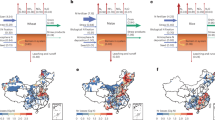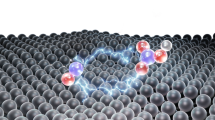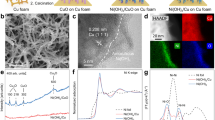Abstract
Nitrogen (N) fertilizer plays a crucial role in agriculture. The conventional production and use of solid nitrogenous fertilizers results in substantial energy consumption and severe groundwater pollution. Here we propose an absorption‒electroreduction relay strategy capable of the distributed production of directly accessible liquid N fertilizer (NH4NO3 solution) from NOx, a common constituent of exhaust gases. When combined with plasma-driven N fixation, the raw feedstock in this strategy can be further extended to air. NOx is first absorbed by an aqueous solution. The NOx− produced as well as the residual NOx are selectively reduced to NH4NO3 by a ruthenium‒cobalt electrocatalyst (Ru9Co91). Through the N balance established between the absorption and electroreduction processes, NH4NO3 solutions are produced continuously without any other additive ions. We successfully constructed an 8-l membrane-free system that outputs 8.5 l h−1 of NH4NO3 solution at a constant concentration (840 mg l−1 of N) to meet the N fertilizer requirements for 20 m2 of farmland. This work offers an alternative route for obtaining N fertilizers, with the potential to improve the sustainability of the N fertilizer supply.
This is a preview of subscription content, access via your institution
Access options
Access Nature and 54 other Nature Portfolio journals
Get Nature+, our best-value online-access subscription
$32.99 / 30 days
cancel any time
Subscribe to this journal
Receive 12 digital issues and online access to articles
$119.00 per year
only $9.92 per issue
Buy this article
- Purchase on SpringerLink
- Instant access to full article PDF
Prices may be subject to local taxes which are calculated during checkout





Similar content being viewed by others
Data availability
Source data are provided with this paper.
References
Friel, S., Schram, A. & Townsend, B. The nexus between international trade, food systems, malnutrition and climate change. Nat. Food 1, 51–58 (2020).
Van Langevelde, P. H., Katsounaros, I. & Koper, M. T. Electro–catalytic nitrate reduction for sustainable ammonia production. Joule 5, 290–294 (2021).
Van der Ham, C. J., Koper, M. T. & Hetterscheid, D. G. Challenges in reduction of dinitrogen by proton and electron transfer. Chem. Soc. Rev. 43, 5183–5191 (2014).
Luo, Y. et al. Selective electrochemical synthesis of urea from nitrate and CO2 via relay catalysis on hybrid catalysts. Nat. Catal. 6, 939–948 (2023).
Kani, N. C. et al. Solar-driven electrochemical synthesis of ammonia using nitrate with 11% solar-to-fuel efficiency at ambient conditions. Energy Environ. Sci. 14, 6349–6359 (2021).
Chen, F. et al. Efficient conversion of low-concentration nitrate sources into ammonia on a Ru-dispersed Cu nanowire electrocatalyst. Nat. Nanotechnol. 17, 759–767 (2022).
Meena, V. S. et al. Plant beneficial rhizospheric microorganism (PBRM) strategies to improve nutrients use efficiency: a review. Ecol. Eng. 107, 8–32 (2017).
Wang, Y., Yu, Y., Jia, R., Zhang, C. & Zhang, B. Electrochemical synthesis of nitric acid from air and ammonia through waste utilization. Natl Sci. Rev. 6, 730–738 (2019).
Alcon, F., Navarro, N., de-Miguel, M. D. & Balbo, A. L. in Sustainable Solutions for Food Security: Combating Climate Change by Adaptation (eds Sarkar, A. et al.) 269–285 (Springer, 2019).
Yang, K., Han, S., Wang, Y., Zhang, B. & Yu, Y. Sustainable production and in-place utilization of a liquid nitrogenous fertilizer. Joule 7, 1948–1955 (2023).
Singandhupe, R., Rao, G., Patil, N. & Brahmanand, P. Fertigation studies and irrigation scheduling in drip irrigation system in tomato crop (Lycopersicon esculentum L.). Eur. J. Agron. 19, 327–340 (2003).
Mikula, K. et al. Controlled release micronutrient fertilizers for precision agriculture–a review. Sci. Total Environ. 712, 136365 (2020).
Inventory of U.S. Greenhouse Gas Emissions and Sinks: 1990–2022 (EPA, 2025); www.epa.gov/ghgemissions/inventory-us-greenhouse-gas-emissions-and-sinks-1990-2022
Zhou, J. et al. Linear adsorption enables NO selective electroreduction to hydroxylamine on single Co sites. Angew. Chem. Int. Ed. 62, e202305184 (2023).
Li, M. et al. Electrosynthesis of amino acids from NO and α-keto acids using two decoupled flow reactors. Nat. Catal. 6, 906–915 (2023).
Li, L. et al. Efficient nitrogen fixation to ammonia through integration of plasma oxidation with electro–catalytic reduction. Angew. Chem. Int. Ed. 133, 14250–14256 (2021).
Liu, H., Bai, L., Bergmann, A., Roldan Cuenya, B. & Luo, J. Electrocatalytic reduction of nitrogen oxide species to ammonia. Chem 10, 2963–2986 (2024).
Li, P. et al. A multifunctional copper single-atom electrocatalyst aerogel for smart sensing and producing ammonia from nitrate. Proc. Natl Acad. Sci. USA 120, e2305489120 (2023).
Chen, F. et al. Electrochemical nitrate reduction to ammonia with cation shuttling in a solid electrolyte reactor. Nat. Catal. 7, 1032–1043 (2024).
Quality Assurance Guidance Document. Model Quality Assurance Project Plan for the PM Ambient Air (EPA, 2001).
Han, S. et al. Ultralow overpotential nitrate reduction to ammonia via a three-step relay mechanism. Nat. Catal. 6, 402–414 (2023).
Koper, M. T. Theory of multiple proton–electron transfer reactions and its implications for electro-catalysis. Chem. Sci. 4, 2710–2723 (2013).
Liu, H. et al. Efficient electrochemical nitrate reduction to ammonia with copper‐supported rhodium cluster and single-atom catalysts. Angew. Chem. Int. Ed. 61, e202202556 (2022).
Medvedev, J. J. et al. Pathways of ammonia electrooxidation on nickel hydroxide anodes and an alternative route towards recycled fertilizers. Green Chem. 24, 1578–1589 (2022).
Ren, Y. et al. Microscopic-level insights into the mechanism of enhanced NH3 synthesis in plasma-enabled cascade N2 oxidation–electroreduction system. J. Am. Chem. Soc. 144, 10193–10200 (2022).
Daiyan, R. et al. Nitrate reduction to ammonium: from CuO defect engineering to waste NOx-to-NH3 economic feasibility. Energy Environ. Sci. 14, 3588–3598 (2021).
Zheng, J. et al. Enhanced NH3 synthesis from air in a plasma tandem-electrocatalysis system using plasma-engraved N-doped defective MoS2. JACS Au 3, 1328–1336 (2023).
Yang, K. et al. Unveiling the reaction mechanism of nitrate reduction to ammonia over cobalt-based electrocatalysts. J. Am. Chem. Soc. 146, 12976–12983 (2024).
Wang, Z., Guo, X., Montoya, J. & Nørskov, J. K. Predicting aqueous stability of solid with computed Pourbaix diagram using SCAN functional. npj Comput. Mater. 6, 160 (2020).
Huang, Y. et al. Pulsed electroreduction of low-concentration nitrate to ammonia. Nat. Commun. 14, 7368 (2023).
Han, S., Wang, C., Wang, Y., Yu, Y. & Zhang, B. Electrosynthesis of nitrate via the oxidation of nitrogen on tensile-strained palladium porous nanosheets. Angew. Chem. Int. Ed. 60, 4471–4478 (2021).
Liu, H. et al. Low-coordination rhodium catalysts for an efficient electrochemical nitrate reduction to ammonia. ACS Catal. 13, 1513–1521 (2023).
Long, J. et al. Direct electrochemical ammonia synthesis from nitric oxide. Angew. Chem. Int. Ed. 59, 9711–9718 (2020).
Tufts, B. J. et al. XPS and EXAFS studies of the reactions of cobalt (iii) ammine complexes with gallium arsenide surfaces. J. Am. Chem. Soc. 112, 5123–5136 (1990).
Acknowledgements
We acknowledge the National Natural Science Foundation of China (Grant Nos. 22071173 to Y.Y., 22271213 to Bin Zhang and 224B2908 to K.Y.) and the Fundamental Research Funds for the Central Universities of China (Bin Zhang). We thank the Haihe Laboratory of Sustainable Chemical Transformations for financial support (Grant No. 24HHWCSS00009 to Y.Y.). We thank Y. Liu in the Analysis and Testing Center at Tianjin University for her assistance with the in situ ATR-FTIR.
Author information
Authors and Affiliations
Contributions
Y.Y. and Bin Zhang conceived the idea and supervised the project. S.H. designed the experiments. S.H., K.Y. and J. Zhou synthesized the materials and carried out the electrochemical measurements. S.H., T.L. and Y.H. carried out the in situ experiments. S.H. and J. Zhou drew the schematic diagram. K.Y. and Baoshun Zhang conducted the magnification experiment. L.G. and J. Zhu performed the COMSOL simulations. Y.Y. and S.H. wrote the paper. Bin Zhang revised the paper with comments from all authors.
Corresponding authors
Ethics declarations
Competing interests
The authors declare no competing interests.
Peer review
Peer review information
Nature Sustainability thanks Mohan Qin, Chuan Xia, Ke Xie, Gong Zhang and the other, anonymous, reviewer(s) for their contribution to the peer review of this work.
Additional information
Publisher’s note Springer Nature remains neutral with regard to jurisdictional claims in published maps and institutional affiliations.
Supplementary information
Supplementary Information
Supplementary Figs. 1–32, Notes 1–8 and Tables 1 and 2.
Supplementary Video 1
Videos for the plasma process.
Supplementary Video 2
Videos for the plasma-electrocatalyst process.
Source data
Source Data Fig. 2
Source data for Fig. 2.
Source Data Fig. 3
Source data for Fig. 3.
Source Data Fig. 4
Source data for Fig. 4.
Source Data Fig. 5
Source data for Fig. 5.
Rights and permissions
Springer Nature or its licensor (e.g. a society or other partner) holds exclusive rights to this article under a publishing agreement with the author(s) or other rightsholder(s); author self-archiving of the accepted manuscript version of this article is solely governed by the terms of such publishing agreement and applicable law.
About this article
Cite this article
Han, S., Yang, K., Gao, L. et al. Synthesis of liquid nitrogenous fertilizer via a nitrogen conversion balance. Nat Sustain 8, 1068–1076 (2025). https://doi.org/10.1038/s41893-025-01619-4
Received:
Accepted:
Published:
Issue date:
DOI: https://doi.org/10.1038/s41893-025-01619-4
This article is cited by
-
Distributed production of ready-to-use liquid nitrogenous fertilizer
Nature Sustainability (2025)



